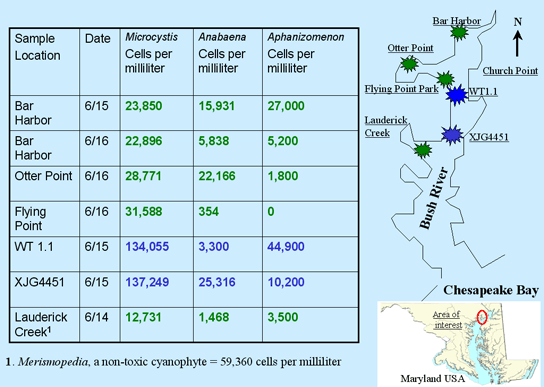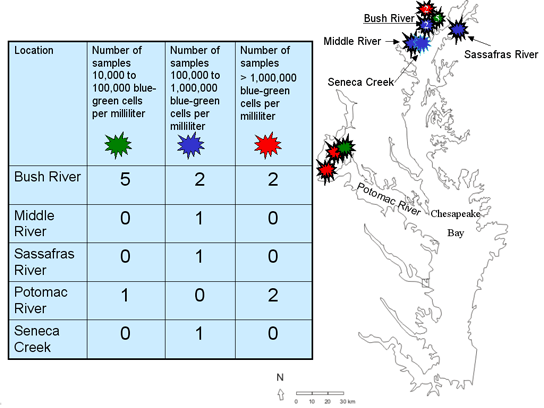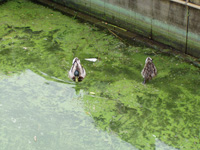June
24 , 2004 |
||||

Maryland Department of the Environment investigated a Seneca Creek bloom site on June 17 in response to a citizen water quality complaint. The investigation indicated Seneca Creek was simultaneously experiencing a filamentous algal bloom and a cyanobacterial bloom (see HAB News from June 24, 2004: "Nuisance filamentous macroalgae expands in Baltimore County to include Seneca Creek."). Microcystis cell concentrations were estimated at 304,628 cells per milliliter. This is the first algal bloom report of the year for the Seneca River system and further expands the waterways where cyanobacterial blooms have been identified in 2004 (Figure 2). 
During summer 2003, the Bush, Potomac and Sassafras Rivers were three of several river systems where widespread blue-green algal blooms were found. Inadvertent swimmers reported skin rashes, itching eyes, stomach aches and fever, and the hepatotoxin (i.e., liver toxin) microcystin was detected in association with summer cyanophyte (blue-green) blooms (see HAB News from October 30, 2003: "Microcystin toxins found across Maryland's Chesapeake Bay in summer 2003."). Not all blooms of blue-green algae produce toxins. Samples in 2004 from the Bush River, Potomac River and Frog Mortar Creek have been sent to Wright State University to test for microcystin toxin content. Results are pending. Pockets of blue-green algal blooms may be encountered during boating and other recreational activities. People should take common precautions to reduce the risk of illness or discomfort related to blue-green algal blooms:
Please note that illness associated with harmful algal blooms is now a reportable illness so physicians should be reporting these to local health departments. The MD DNR in coordination and cooperation with DHMH and MDE will continue to monitor all blue-green algal blooms throughout the state. For up to date information on all of Maryland's harmful algal blooms and water quality, please visit Eyes on the Bay |

 Maryland
Department of Natural Resources sampled water from the middle to upper
Bush River (Harford Co.) between June 14-16 during routine water quality
monitoring and continued tracking of existing cyanobacterial (blue-green
algal) bloom conditions. Bloom conditions remain widespread but intensity
declined from concentrations detected between June 1 and 9 at Flying Point
State Park and Otter Point State Park (see HAB News from June 11, 2004:
"
Maryland
Department of Natural Resources sampled water from the middle to upper
Bush River (Harford Co.) between June 14-16 during routine water quality
monitoring and continued tracking of existing cyanobacterial (blue-green
algal) bloom conditions. Bloom conditions remain widespread but intensity
declined from concentrations detected between June 1 and 9 at Flying Point
State Park and Otter Point State Park (see HAB News from June 11, 2004:
"